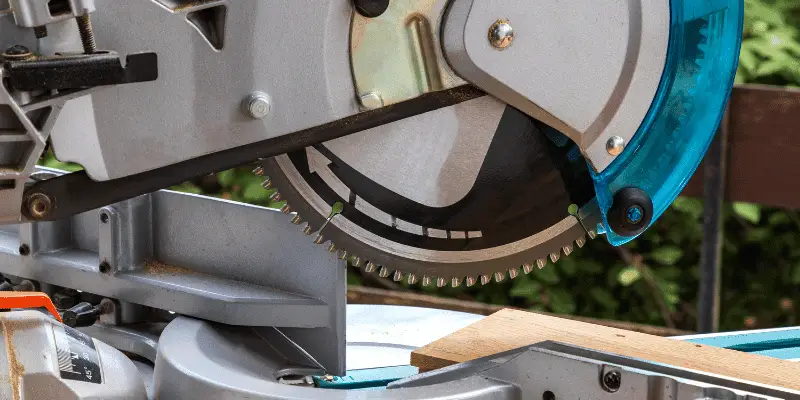A dual bevel miter saw can tilt in both directions, making it more versatile than a single bevel miter saw. This feature allows for easier and quicker bevel cuts without having to flip the workpiece.
When deciding between the two, it’s important to consider your specific cutting needs and the level of convenience you require. Both types of saws have their advantages and disadvantages, and understanding the difference will help you make an informed decision.
We will explore the key differences between dual and single bevel miter saws and highlight the unique features of each. By the end, you’ll have a better understanding of which type of miter saw is best suited to your woodworking projects.
Understanding Dual And Single Bevel Miter Saws
Definition Of Dual And Single Bevel Miter Saws
When it comes to woodworking and carpentry, having the right tools is essential for achieving precise and accurate cuts. Two types of miter saws that are commonly used are dual and single bevel miter saws. Understanding the differences between these two types of saws is crucial for selecting the most suitable tool for your specific cutting needs.
Key Differences Between Dual And Single Bevel Miter Saws
Dual and single bevel miter saws are both designed to make angled cuts, but they have distinct differences in terms of functionality and flexibility. Let’s take a closer look at the key disparities between these two types of miter saws to help you make an informed decision when choosing the right tool for your woodworking projects.
Benefits And Limitations Of Dual Bevel Miter Saws
When it comes to woodworking, the choice between a dual bevel miter saw and a single bevel miter saw can have a significant impact on the quality and efficiency of your projects. In this post, we will delve into the benefits and limitations of dual bevel miter saws to help you make an informed decision when considering the right tool for your woodworking needs.
Advantages Of Using Dual Bevel Miter Saws
Precision and Efficiency: Dual bevel miter saws allow for quick and precise cuts in both left and right directions, eliminating the need to flip your workpiece, resulting in a more efficient workflow.
Versatility: The ability to make bevel cuts in both directions without having to adjust the workpiece or the saw itself offers greater versatility, making it suitable for complex projects that require various angles and cuts.
Time-Saving: The dual bevel feature enables you to make quick and accurate cuts without the need for frequent adjustments, saving valuable time during your woodworking projects.
Limitations Of Dual Bevel Miter Saws
Complexity: Dual bevel miter saws can be more complex to operate and require a learning curve for beginners compared to single bevel miter saws.
Cost: Due to their advanced features and capabilities, dual bevel miter saws are generally more expensive than single bevel miter saws, which could be a limiting factor for budget-conscious woodworkers.
Applications And Best Uses For Dual Bevel Miter Saws
Crown Molding and Trim Work: Dual bevel miter saws excel in cutting crown moldings and undertaking detailed trim work where precision and versatility are crucial.
Furniture Making: For furniture projects that involve intricate angles and bevels, dual bevel miter saws offer the precision and flexibility required for creating professional-grade pieces.
Advantages And Drawbacks Of Single Bevel Miter Saws
When it comes to woodworking and carpentry, the choice between a single bevel miter saw and a dual bevel miter saw can significantly impact the quality and efficiency of the work. In this section, we will delve into the advantages and drawbacks of single bevel miter saws, providing valuable insights for both beginners and seasoned professionals.
Advantages Of Using Single Bevel Miter Saws
Single bevel miter saws offer several advantages that make them a valuable tool in woodworking and carpentry projects:
- Cost-effective: Single bevel miter saws are generally more affordable than their dual bevel counterparts, making them a budget-friendly option for DIY enthusiasts and small workshops.
- Simplicity: With a single bevel miter saw, there is no need to adjust the bevel in two directions, simplifying the cutting process and reducing the chances of errors.
- Portable: Many single bevel miter saws are compact and lightweight, allowing for easy transport between job sites or within a workshop.
- Easy to operate: The single bevel design makes these saws user-friendly and suitable for individuals who are new to woodworking.
Drawbacks Of Single Bevel Miter Saws
While single bevel miter saws offer several advantages, they also come with a few drawbacks that should be considered:
- Limited flexibility: Due to the single bevel design, users are restricted to making bevel cuts in one direction, which may be a drawback for complex projects.
- Time-consuming: Single bevel miter saws require readjustment for each bevel cut in the opposite direction, resulting in a slower workflow compared to dual bevel saws.
- Not suitable for intricate cuts: Some intricate woodworking projects may require the flexibility of a dual bevel miter saw to achieve precise and complex cuts.
Applications And Best Uses For Single Bevel Miter Saws
Single bevel miter saws are well-suited for a variety of applications, including:
- Trim work: Cutting trim and molding at common angles can be efficiently carried out using a single bevel miter saw.
- Basic woodworking: For simple DIY projects and basic woodworking tasks, a single bevel miter saw can fulfill most cutting requirements.
- Small-scale carpentry: In small workshops or for occasional carpentry needs, a single bevel miter saw provides a cost-effective cutting solution.
Considerations For Choosing The Right Miter Saw For Your Projects
When embarking on woodworking projects, choosing the right miter saw is crucial to achieving precision and efficiency. One of the primary decisions that woodworkers face is whether to invest in a dual bevel miter saw or a single bevel miter saw. Each type has its distinct advantages, and knowing the considerations for selecting the right miter saw can make a significant difference in project outcomes.
Factors To Consider When Choosing Between Dual And Single Bevel Miter Saws
Before making a decision between a dual and single bevel miter saw, there are several critical factors to consider. Understanding these factors will help you determine which type of miter saw best suits your specific woodworking needs:
- Cutting Capacity: Evaluate the maximum cutting width and depth required for your projects.
- Beveling Convenience: Consider the frequency of bevel cuts and the convenience of adjusting bevel angles.
- Accuracy and Precision: Compare the precision and accuracy of cuts produced by each type of miter saw.
- Cost and Budget: Analyze the cost difference between dual and single bevel miter saws and assess your budget constraints.
- Versatility: Assess the versatility of each miter saw type in accommodating various cutting angles and bevel directions.
Project Specific Considerations For Miter Saw Selection
When selecting a miter saw for your projects, it’s essential to consider the specific requirements of the woodworking tasks at hand. Different projects may demand varying capabilities from the miter saw, such as:
| Project Type | Ideal Miter Saw Type |
|---|---|
| Crown Molding Installation | Dual Bevel Miter Saw for precise bevel cuts |
| Furniture Making | Single Bevel Miter Saw for cost-effective straight cuts |
| Picture Framing | Dual Bevel Miter Saw for efficient angle adjustments |
Tips For Making The Best Decision
To make an informed decision when choosing between dual and single bevel miter saws, keep the following tips in mind:
- Evaluate Project Scope: Understand the specific requirements of your projects to determine the most suitable miter saw type.
- Test Functionality: If possible, test both types of miter saws to assess their performance and ease of use.
- Consider Future Projects: Anticipate the likelihood of future projects that may demand the capabilities of a particular miter saw type.
- Seek Expert Advice: Consult with experienced woodworkers or professionals to gain insights on the most suitable miter saw for your needs.

Frequently Asked Questions Of Dual Vs Single Bevel Miter Saw
What Are The Key Differences Between A Dual Bevel And Single Bevel Miter Saw?
A dual bevel miter saw can tilt in both directions, while a single bevel can only tilt in one. This allows more flexibility in cuts with the dual bevel option, reducing the need to flip the workpiece.
How Does The Bevel Type Affect The Accuracy Of Cuts With A Miter Saw?
Dual bevel saws provide greater accuracy as the angle can be adjusted without moving the workpiece. Single bevel saws require adjustment of the workpiece, making them less precise and adding more complexity to the cutting process.
Which Bevel Type Is More Suitable For Beginners?
Single bevel miter saws are often more user-friendly for beginners due to their simpler operation. Dual bevel saws may be more complex, requiring a steeper learning curve, but provide greater versatility for experienced users.
What Factors Should I Consider When Choosing Between A Dual And Single Bevel Miter Saw?
Consider the type of projects you’ll be working on, the level of precision required, and your experience level. Dual bevel saws offer more flexibility but may be unnecessary for certain projects, making a single bevel saw a more practical choice.
Conclusion
Both dual and single bevel miter saws have their unique advantages. The choice ultimately depends on your specific needs and budget. Considering the type of projects you frequently tackle and the level of precision required will help you make an informed decision.
However, it’s important to remember that both types are valuable tools in any workshop.



2 thoughts on “Dual Vs Single Bevel Miter Saw: Which is Best for Your Projects?”